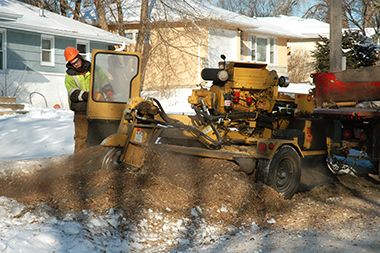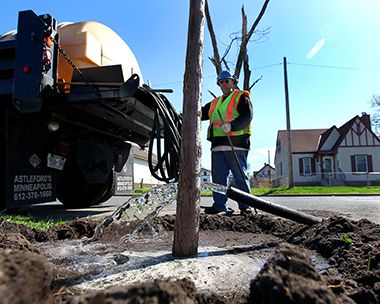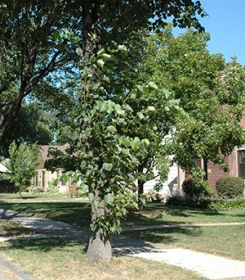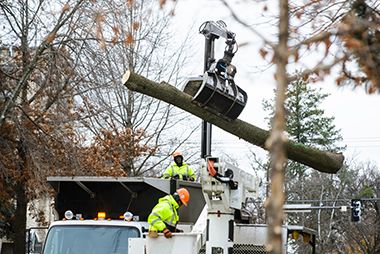 We hire private companies to grind stumps because it is the most cost effective. Competitive bids are solicited from qualified contractors each year. The companies with the lowest prices are awarded a contract to grind a portion of as many as 8000+ stumps annually. The Forestry Department can spend over $500,000 annually on stump grinding. Contractors grind the stump below the surrounding soil or deeper if we need to plant a new tree in the same location.
We hire private companies to grind stumps because it is the most cost effective. Competitive bids are solicited from qualified contractors each year. The companies with the lowest prices are awarded a contract to grind a portion of as many as 8000+ stumps annually. The Forestry Department can spend over $500,000 annually on stump grinding. Contractors grind the stump below the surrounding soil or deeper if we need to plant a new tree in the same location.
Stump grinding is performed according to strict specifications. The three main descriptions for stump grinding are shallow, regular or deep. “Shallow” grinds are about 4 inches deep and are mostly performed in parks. The majority of boulevard stumps are ground 8 inches deep which is a “regular” grind. “Deep” grinds are 18 inches deep and are performed when the new tree must be planted in exactly the same spot as the stump.
With all stump grinding on boulevards, the wood chips that are generated during the grinding process are picked up and hauled away for recycling. New topsoil is replaced in the hole. It is slightly mounded to allow for settling. We do not apply grass seed to the new soil area due to the seasonable variability of when grinding occurs. Propertry owners may reseed the boulevard if they choose to do so. Reseeding should not be done if a new tree is scheduled where a deep grind was performed. To know where a new tree will be planted, look for a white T on the curb.
All boulevard stump grinding is dependent upon budgeted funds. Because new stumps are generated throughout the calendar year, it is more efficient and cost effective to wait until annual tree removals are completed before assigning stumps to a contractor. For this reason, stumps are usually not removed until the year following the removal of the tree.
While there are fewer deep grinds than regular grinds, there is no way to know from year to year what the exact count of each will be. To ensure that as many regular grinds as possible are completed, deep grinds are typically performed after regular grinds. If after completing regular grinds enough funds remain, deep grinds may begin in the fall. If completing regular grinds exhausts the budget, deep grinds will likely be completed in the late winter or early spring of the following year. Either way, this ensures that stumps requiring a deep grind are removed in preparation for the spring planting season.
The budgeted funds available determine how many stumps we can grind and when. There are years when we may not have enough resources to grind every stump that is created. In these cases, such stumps will be completed using funding from the subsequent year’s budget appropriaton.








 We carefully consider the species and location of each public tree we plant. It will affect the area around it for many years and we want each tree to thrive.
We carefully consider the species and location of each public tree we plant. It will affect the area around it for many years and we want each tree to thrive.


 We will remove a boulevard tree if the tree:
We will remove a boulevard tree if the tree: We hire private companies to grind stumps because it is the most cost effective. Competitive bids are solicited from qualified contractors each year. The companies with the lowest prices are awarded a contract to grind a portion of as many as 8000+ stumps annually. The Forestry Department can spend over $500,000 annually on stump grinding. Contractors grind the stump below the surrounding soil or deeper if we need to plant a new tree in the same location.
We hire private companies to grind stumps because it is the most cost effective. Competitive bids are solicited from qualified contractors each year. The companies with the lowest prices are awarded a contract to grind a portion of as many as 8000+ stumps annually. The Forestry Department can spend over $500,000 annually on stump grinding. Contractors grind the stump below the surrounding soil or deeper if we need to plant a new tree in the same location.